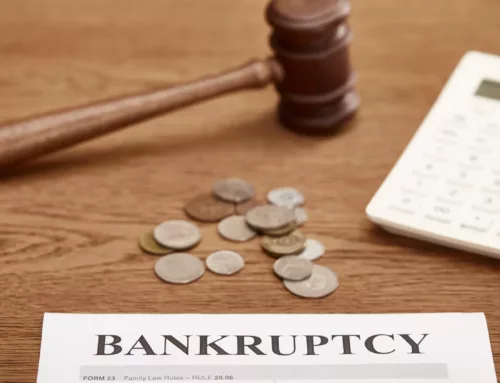How Can Bankruptcy Be the Lifesaver?
Money problems are challenging, and the stress can feel doubled when you’re dealing with them as a married couple. That’s why we’ve put together this straightforward guide on how to file for bankruptcy as a married couple.
Sharing a life means sharing everything, including debts. These financial burdens can strain your relationship immensely, making it difficult to see a path forward. But there is a solution: bankruptcy. This could be the shared answer to get you and your spouse back toward a secure financial future.
We aim to deliver this vital information in a way that’s easy for anyone to understand. This guide can help you find a path through the rugged terrain of debt and start the journey to financial recovery.
In need of some guidance during this stressful time? The bankruptcy attorneys at Hammerschmidt Stickradt & Associates in Royal Oak, Michigan, are ready to help. Reach out to us today for a free consultation. We’re here to help you navigate through these tough financial times.
Bankruptcy As A Way Out of Debt for Couples
When you’re in heavy debt, it can feel like there’s no way out. But for many couples, bankruptcy can be a lifeboat in the stormy seas of financial hardship. It’s not a sign of failure but a legal process designed to help people regain control over their finances.
In simple terms, bankruptcy is a way to eliminate or repay debts under the protection of the bankruptcy court. Two common types in the United States are Chapter 7 and Chapter 13. Chapter 7 is about liquidating assets to wipe out your debts, while Chapter 13 allows you to create a plan to repay them over time.
Both types provide relief, but they do so in different ways and come with their own pros and cons. As a couple, it’s essential to understand these differences to identify the best option for your situation.
Bankruptcy is a significant decision with far-reaching consequences. It can impact your credit, future loan possibilities, and emotional well-being. But for many couples, it’s the crucial first step towards a more secure financial future. In the next section, we’ll dive deeper into Chapter 7 and Chapter 13 to help you better understand these paths.
The Bankruptcy Legal Process: A Closer Look
Filing for bankruptcy is a legal maneuver when you cannot pay back your debts. The aim is to obtain protection from a federal court that can relieve the mounting pressures of debt. Here’s a closer look at how this process works:
- Initiating the Process: The bankruptcy process starts with filing a petition in bankruptcy court. This isn’t a simple ask; it’s a formal legal request asking the court to declare you cannot pay your debts.
- Comprehensive Financial Picture: The petition you file must include detailed information about your financial situation. This encompasses your income (from all sources), all your debts (big or small, secured or unsecured), and all your assets (property, cars, savings, etc.). By requiring this, the court aims to understand your financial state to make informed decisions about your case.
- Automatic Stay: An ‘automatic stay’ occurs once your petition is filed. This legal provision stops most creditors from pursuing their collection activities. They can no longer make harassing phone calls, send demanding letters, or take legal action against you to recover their debts. This stay provides breathing space to regroup, plan your next steps, and start working towards a better financial future.
Remember, bankruptcy laws are complex, and navigating this process can be challenging. That’s where we at Hammerschmidt Stickradt & Associates step in. Our role is to guide you through each step, helping you understand the implications and make informed decisions.
Chapter 7 vs. Chapter 13
Deciding between Chapter 7 and Chapter 13 bankruptcy can be challenging, but understanding their fundamental differences can help. Chapter 7, also known as ‘liquidation bankruptcy,’ is typically faster, wiping out qualifying debts entirely after certain assets are sold. However, not all debts can be eliminated, and not everyone qualifies for Chapter 7.
On the other hand, Chapter 13, known as ‘reorganization bankruptcy,’ involves setting up a 3-5 year payment plan to repay your debts. You don’t have to liquidate your assets, making it a good choice if you have consistent income and want to keep assets like a house or car.
The decision between Chapter 7 and Chapter 13 depends on various factors, such as your income, the type and amount of debt, and your long-term financial goals. It’s important to review your circumstances carefully and consider seeking advice to make the best decision. In the next section, we’ll look at the pros and cons of filing bankruptcy as a couple.
Making the Decision: Joint or Individual Bankruptcy?
For married couples facing bankruptcy in Michigan, one of the first decisions to make is whether to file jointly or individually. The best choice depends on the couple’s unique financial circumstances and the nature of their debts. Understanding the advantages and disadvantages of each route can guide you to a decision that best protects your shared future.
Pros and Cons of Filing Jointly
It allows you to consolidate all your debts into a single case, leading to just one court process and one set of fees. This efficiency often makes joint filing an attractive option.
However, it’s important to know that in Michigan, exemptions—legal protections that keep certain property safe from creditors—are not automatically doubled in a joint bankruptcy case. This means that even if your debts are jointly held, your assets may not get double the protection.
When to Consider Filing Separately
In certain situations, filing for bankruptcy could be the better choice. For instance, filing could shield the other spouse’s credit rating if the majority of debt is in one spouse’s name.
Filing may also be a good option if one spouse owns separate property, as it can protect those assets from being involved in the bankruptcy process. Moreover, certain exemptions in Michigan law, such as the homestead exemption, can be doubled if each spouse files separately.
Choosing between joint or individual bankruptcy is a complex decision with many factors. It’s crucial to examine your financial circumstances closely and, where possible, seek professional guidance to help determine the most advantageous path. In the next section, we’ll discuss the steps involved in filing for bankruptcy as a married couple in Michigan.
A Step-by-Step Guide to Filing for Bankruptcy as a Couple
Embarking on the journey of filing for bankruptcy as a married couple in Michigan involves several steps. It’s a legal process that requires careful preparation and understanding of the path ahead. Below, we’ll break down these steps to help you navigate this process more efficiently.
Preparing to File: What You Need to Know
Filing for bankruptcy requires careful preparation. Here’s what you need to know before you file:
- Collect all relevant financial documents: You’ll need bank statements, credit card statements, loan documents, and details about your income and expenses. A comprehensive list of your assets and liabilities is also essential. It’s important to get a complete picture of your financial situation.
- Complete credit counseling: A mandatory step before filing for bankruptcy is credit counseling from a government-approved agency. This needs to be completed in the six months before filing your case.
- Fill out the required bankruptcy forms: These documents will detail your financial situation and propose a plan for dealing with your debts. Honesty is vital in this process. Any attempt to hide assets or lie about your financial situation can result in your bankruptcy case being dismissed or, in severe cases, could lead to criminal charges.
By being well-prepared and honest, you can smooth out the bankruptcy filing process and move toward financial recovery.
Life After Bankruptcy: Moving Forward Together
Navigating life after bankruptcy involves careful planning and a proactive financial management approach. Here’s a guide to help you move forward together:
- Understand the impact on your credit: Bankruptcy can stay on your credit report for seven to ten years, affecting your ability to secure credit. However, the effect lessens over time.
- Create and stick to a budget: Budgeting is crucial in managing your finances and avoiding falling back into unmanageable debt.
- Boost your income and cut expenses: Seek ways to increase or reduce costs wherever possible.
- Build an emergency fund: This can provide a safety net and prevent future financial distress.
- Embrace the fresh start: Bankruptcy is not an end but a chance to learn from the past and build a stronger financial future together.
Remember, it’s not an easy journey, but with careful planning, determination, and the proper guidance, you can navigate the path to financial stability. Hammerschmidt Stickradt & Associates offers a free consultation to help you start your journey toward financial relief and recovery. Don’t navigate the complexities of bankruptcy alone. Contact us today to take your first step.
Get the Help You Need Today
Facing bankruptcy as a married couple isn’t easy, but remember – you’re not alone. Our experienced legal team at Hammerschmidt Stickradt & Associates is here to guide you through every step of the bankruptcy process.
Are you dealing with abusive creditors? Struggling under the weight of credit card debt? Facing the threat of wage garnishment? Or perhaps you’re unsure which type of bankruptcy is right for you. Regardless of your situation, our mission is to help you.
Bankruptcy doesn’t have to be the end of your financial journey. It can be the beginning of a more secure and debt-free future. Take the first step today – contact us for a free consultation. Let’s navigate the path to financial relief together.



